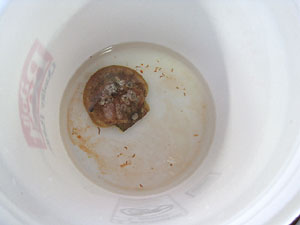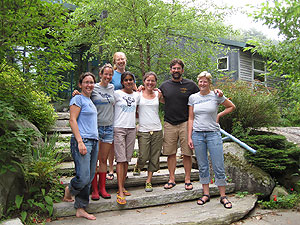

 | |||||||||||
|
|
Journals 2009/2010Jennifer Emblidge
August 21, 2009 I certainly will miss the whole Wahle lab crew and the lobsters of Maine. My last day in the lab consisted of sample sorting. My goal was to finish the Oak's Island samples for the lab before I had to head for home. I was able to get them sorted, measured and recorded! The weekly Wahle lab meeting was scheduled for after the elastomer tagging. The tagging was the main priority for team lobster today since they plan to release the tagged lobsters this coming Monday in the Damariscotta River. I had to miss out on the actual tagging because of my sorting goal for the day, but team lobster said the tagging was a success and they seemed content with the outcome. Now, we just need to hope that they can successfully locate the tagged larva when they return, after the release, to suction sample the area. For information regarding why they are using the elastomer tagging, you can refer to the August 16, 2009 journal entry. The start time for the lab meeting also depended on the progress of team scallop. They had lots to do today because the scallops had finally started their spawning. As soon as I arrived to the lab this morning I saw smiles on the faces of the scallop team members. They finally were able to bask in their success at getting the scallops to spawn. This time, they tried using cold temperatures to induce spawning. Last night they placed some scallops in the 12°C cold room to try and cold shock them. It worked definitely worked out for them. This morning the scallops were spawning like crazy! Hoorah! I was able to view some of the fertilized eggs under the scope as Katherine pointed out the different phase of mitosis to me. It was so neat to see the eggs and recognize the stages of division!
I saved the head honcho of the lab for my last entry. You will be introduced to Rick Wahle himself today. In 1990, Rick earned his Ph.D. in Zoology from University of Maine. He earned his Master's degree in Biology from San Francisco State University in 1982 and his Bachelor's degree in Zoology from the University of New Hampshire in 1977. Currently, his research interests are spread among many different fields that the lab dabbles within. Their studies are focused around the fields of ecology, oceanography and fisheries conservation and management. Obviously, I am sure you have seen by now, the main attraction in the Wahle lab are the American lobsters. The lobster work seems to be what the lab is recognized most for, but as you can tell from all of my entries, there is so much more awesome work going on in their lab as well. The lobsters seem to catch everyone's attention first. That is probably best explained by the fact that lobsters are of utmost importance to the continued survival of Maine's economy. Just from my one visit to Maine, it seems to me that a lot of employment in Maine has its roots or attachment in one way or another to the lobsters. Some of Rick's other research interests are centered around lobster recruitment ecology, deep sea red crab ecology, and sea urchin reproductive ecology. The excitement over lobster tagging and scallop spawning took a lot of Rick's time and attention today. In addition to that, Rick had to prepare for the afternoon lab meeting and finish up a grant proposal that he was in the middle of writing. Due to these time constraints, I was only able to fit in one interview questions before the Wahle lab meeting and my departure. However, if there are any of you who have more questions for Rick or another member of the Wahle lab, please do not hesitate to contact me. They are all more then welcome to the idea of sharing more with you. I decided to finish my interview process with Rick by asking him the same question that I asked Charlene earlier in the week. I asked, " Why lobsters?" Just let me begin Rick's answer for you by explaining that there were many answers and parts to Rick's answer and my short explanation will not be able to grasp the completeness of Rick's actual answer. Rick began by looking as if it was a difficult questions but then dug right in as if he had been asked this question many times. After I had asked the question, Rick began a very thorough, fast paced answer that I was unable to completely capture due to my limitations is recording skills. Rick began his answer by smiling and saying with a certain fondness that he had "always had a hankering for crustaceans." He cleared this up further by explaining that his hankering was because of his fascination with the aesthetics of crustaceans, not just their taste. He went on to explain that his work with lobsters was also a matter of history. When he entered his Ph.D. program, he was interested in ecology and his advisor, Bob Steneck, had just received a large sum of money to begin a Sea Grant project looking at the long term consequences of harvesting large male lobsters. In particular, they were going to examine if there was a possible artificial selection process going on that was favoring earlier reproductive maturity. Another reason he leaned towards lobsters are because they are an excellent fishery and use their nursery grounds as a wonderful model to study many different aspects of ecology. It is also easy to convince people to use the lobsters as a model fishery because of their importance to Maine and because they are the largest invertebrate in the North Atlantic. This allowed Rick to do what he enjoys and link ecology together with the lobster fishery. The invention of the suction sampler opened many doors for the lab and enabled them to use the lobster fishery to forecast and make predictions. It also led the lab down many other avenues. For example, the lab has been working for the past twenty years on developing a lobster settlement index. This has allowed the lab to use their fieldwork along the Northeast coast to perform long term monitoring. Jana presented her work to the lab during the lab meeting. The Wahle lab does an excellent job at staying connected and involved with all of the different and exciting projects that they are involved in. They normally schedule presentations like this to keep one another updated and share comments and concerns. I will miss working with them and I enjoyed my stay! Thank you Rick, Charlene, Victoria, Mahima, Lee, Katherine, Jana, and Noah!!!
|
||||||||||

